

Christmas is a Christian festival held annually to celebrate the birth of Jesus. This was complicated somewhat because the birthdate of Jesus is unknown, but of course the choice of the winter soltice can not be accidental. The origin of Christmas celebrations is unknown. Scholars believe that it is in part derived from the pre-Christian rites of Germanic and Celtic tribes
held in celebration of the winter soltice. Christmas was not celebrated by early Christians. One source suggests that the Emperor Constantine the Great in the Fourth Century chose December 25th to celebrate Jesus' birthday because it was the holy day of Mithras--Christianity's chief rival at the time. The early Church as a way of converting the pagans commonly tured pagan celebrations into Christian celebrations. Christmas is just one such holiday. Modern Christmas is thus a blend of Christian mixed with Celtic, Roman, Zoroastrian, and other influences. The acrual infliences vary from country to country meaning that the celebration of Christmas varies around the world.
The Celts played a major role in the evolution of Eropean civilization, altough that role is not fully recognized. The modern observation of Christmas shares many similarities with ancient Celtic winter festivals. The Celtic priests called Druids taught the Celts to bring greens such as mistletoe and holly into their dwellings to honor the god of farming. The pre-Christian Celts considered the winter soltice og great importanc and there were important rites held to celebtate it.
Christmas is one of the many ways in which ancient Rome has shaped and continues to affects our modern world. Saturnalia, the ancient Roman festival in honor of
Saturn the god of Agriculture, is perhaps the most important pagan influence on Christmas, in large measure determining the selection of the date (December 25) and the nature of the celebration until Victorian times. The Scandinavian Yule festival is another major influences on modern Christmases. Most of the supposedly secular customs of Christmas are actually Pagan in origin. Evergreen trees and holly which remained green throughout the long nights and cold were a promise that spring would once again return to the land. These symbols may also have been a connection to the nature spirits who have sway over the return of the warm days.
One of the world's great religious traditions is Zoroastrianism. This religion had a profound influence on Judiasm and Christiasnity. There are many similarities in the theological tradition of these three religions. Zoroastrians priests even have an important role in the Christian Christmas tradition. Zoroastrians believed in a mesiash and savior. Many modern scholars believe that the three Majai (wisemen) mfrom the east were in fact Zoroastrian priests. They were certainly not kings, this is a misinterpretation, probably because early Christian scholares did not want any associaation with nagicians/soccerors.
Christmas was not a holiday observed by the early Christians, although practives differed from congregation to congregatioin. Earch Church scholares do not mention Christmas. The first practioners of the Jesus movement followed Jewish religius custom. Only grdually did Grco-Roman practices begin to dominate. Both Irenaeus and Tertullian fail to include Christmas on threir list of feasts. Origen maintained influenced by the attention goive to the bityhday of emperors insisted that in the Scriptures only sinners. not saints, celebrated their birthdays. Arnobius mocked the "birthdays" of the gods. [Catholic-CE] The preminant religious festival In the early church was Easter. As Christmas began to be celebrated, the character of the early celebrations was much more like Saturnnalia than our modern Christmas. One popular custom during the Christmas season in medieval Europe was the Boy Bishop.
|
Our modern celebrtion of Christmas was largely set in Victorian England.
The two major influences were Queen Victoria and Charles Dickens. Queen Victoria's large family was presented as an exemplear First Family. Charles Dickens was of course the author of "A Christmas Carrol". Between them
they help set the idea that Christmas was a day centered on the family.
A holiday where families put on their best clothes and after Christmas
church services congregated for sumptuous feasting. Other mainstays of Christmas developed during the Victorian era, such as Christmas cards and Christmas trees. The Germans traditionally had Christmas trees since pre-Christian days. Prince Albert introduced Christmas trees to him family and the practice soon spread throughout Britain. The evolving Victoruan traditiin in Britain as well as German immigrants brought the Christmas tree to America. Many essentially heathen, pre Christain customs were integrated in the celebration of Christmas, including the use of holly, mistletoe, Yule logs, and wassail bowls. Games were very popular for Victorian children. The cards on this page show two popular ganes. The boys wear early 19th Century
skeleton suits, althought the cards are probably not contemporary. The children are playing party games in skeleton suits with large
ruffled collars. The games are described. The first is "Forfeits," the
girl holds an object belonging to one of the children, the boy hiding his face so as
not to know which one, then names a forfeit that that child must do. The
second is a game called "Snapdragon", apparently raisins were covered with
Brandy or other spirits, set alight, then the children had to snatch
them from the flames. Not supprisingly, this one has since died out.
Navigate the Boys' Historical Clothing Web holiday pages:
[Return to the Main Chrisrtmas page]
[Return to the Main holiday page]
[New Years]
[Valetines]
[St. Patrick's Day]
[Easter]
[Fourth of July]
[Haloween]
[Thanksgiving]
Navigate the Boys' Historical Clothing Web Site:
[Introduction]
[Activities]
[Biographies]
[Chronology]
[Clothing styles]
[Countries]
[Topics]
[Bibliographies]
[Contributions]
[FAQs]
[Glossaries]
[Images]
[Satellite sites]
[Tools]
[Boys' Clothing Home]
